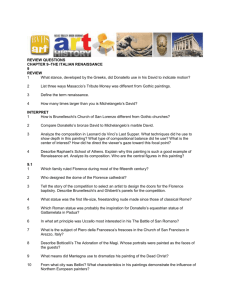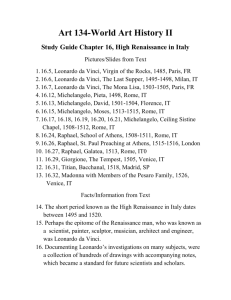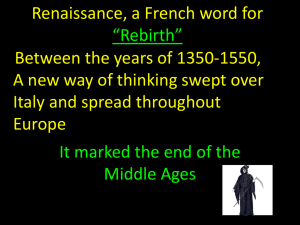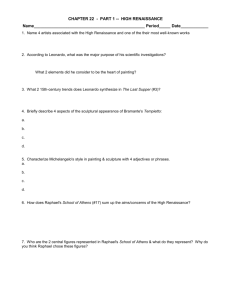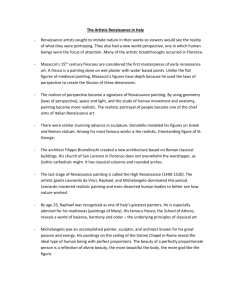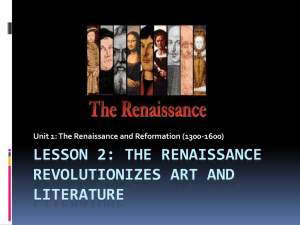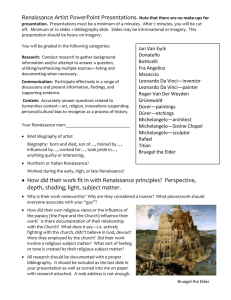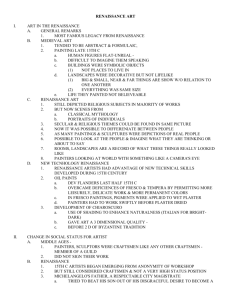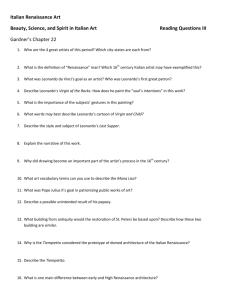World History
advertisement
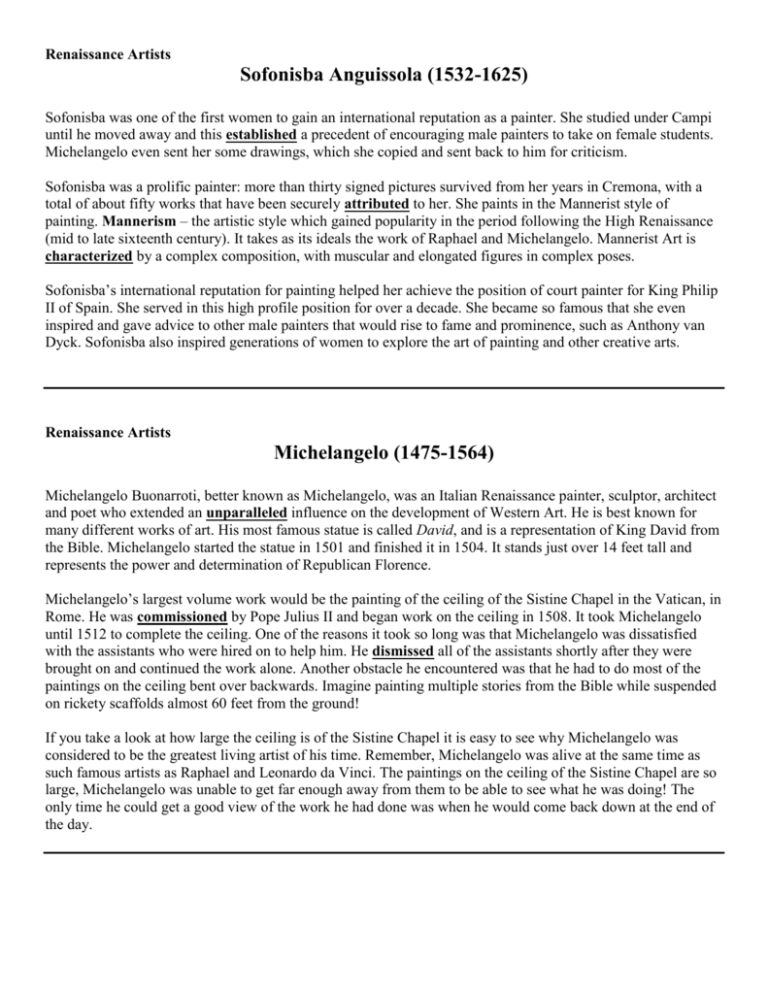
Renaissance Artists Sofonisba Anguissola (1532-1625) Sofonisba was one of the first women to gain an international reputation as a painter. She studied under Campi until he moved away and this established a precedent of encouraging male painters to take on female students. Michelangelo even sent her some drawings, which she copied and sent back to him for criticism. Sofonisba was a prolific painter: more than thirty signed pictures survived from her years in Cremona, with a total of about fifty works that have been securely attributed to her. She paints in the Mannerist style of painting. Mannerism – the artistic style which gained popularity in the period following the High Renaissance (mid to late sixteenth century). It takes as its ideals the work of Raphael and Michelangelo. Mannerist Art is characterized by a complex composition, with muscular and elongated figures in complex poses. Sofonisba’s international reputation for painting helped her achieve the position of court painter for King Philip II of Spain. She served in this high profile position for over a decade. She became so famous that she even inspired and gave advice to other male painters that would rise to fame and prominence, such as Anthony van Dyck. Sofonisba also inspired generations of women to explore the art of painting and other creative arts. Renaissance Artists Michelangelo (1475-1564) Michelangelo Buonarroti, better known as Michelangelo, was an Italian Renaissance painter, sculptor, architect and poet who extended an unparalleled influence on the development of Western Art. He is best known for many different works of art. His most famous statue is called David, and is a representation of King David from the Bible. Michelangelo started the statue in 1501 and finished it in 1504. It stands just over 14 feet tall and represents the power and determination of Republican Florence. Michelangelo’s largest volume work would be the painting of the ceiling of the Sistine Chapel in the Vatican, in Rome. He was commissioned by Pope Julius II and began work on the ceiling in 1508. It took Michelangelo until 1512 to complete the ceiling. One of the reasons it took so long was that Michelangelo was dissatisfied with the assistants who were hired on to help him. He dismissed all of the assistants shortly after they were brought on and continued the work alone. Another obstacle he encountered was that he had to do most of the paintings on the ceiling bent over backwards. Imagine painting multiple stories from the Bible while suspended on rickety scaffolds almost 60 feet from the ground! If you take a look at how large the ceiling is of the Sistine Chapel it is easy to see why Michelangelo was considered to be the greatest living artist of his time. Remember, Michelangelo was alive at the same time as such famous artists as Raphael and Leonardo da Vinci. The paintings on the ceiling of the Sistine Chapel are so large, Michelangelo was unable to get far enough away from them to be able to see what he was doing! The only time he could get a good view of the work he had done was when he would come back down at the end of the day. Renaissance Artists Donatello (1386-1466) Donato di Niccolo di Betto Bardi, universally known as Donatello, was born in Florence, Italy in 1386. The power expressivity of his art made him the greatest sculptor of the Early Renaissance. Donatello was both a master of sculpture in marble and bronze. A good deal in known about his life and career, but little is known about his character and personality. He never married and he seems to have been a man of simple tastes. Patrons often found him hard to deal with in a day when artists’ working conditions were regulated by guild rules. His Humanist friends attest that he was a connoisseur of ancient art. The inscriptions and signatures on his works are among the earliest examples of the revival of classical Roman lettering. He had a more detailed and wide-ranging knowledge of ancient sculpture than any other artist of his day. The full power of his work first appeared in two marble statues, St Mark and St. George (both were completed around 1415), which were done for San Michele, the church of Florentine guilds. Here, one can see for the first time since classical antiquity, the human body is rendered as a self-activating, functional organism, and the human personality is shown with confidence in its own worth. His most famous bronze work, and most important, was the Feast of Herod. It is an intensely dramatic relief with an architectural background that first displayed Donatello’s command of scientific linear perspective. Renaissance Artists Masaccio (1401-1428) Tommaso di Ser Giovanni di Simone Guidi Cassai called Masaccio is ranked the greatest master of the Early Italian Renaissance Painting. He is best known for his use of scientific perspective that helped inaugurate the modern era of painting. Masaccio was born in San Giovanni Valdarno, near Florence, on December 21, 1401. He joined the painters’ guild in Florence in 1422. His remarkable individual style was truly his own and he seemed to be influenced more by Brunelleschi, who was an architect, and Donatello, who was a sculptor. Both of these men were his contemporaries in Florence. From Brunelleschi he acquired a mathematical knowledge of proportion that was crucial to his revival of the principles of scientific perspective. From Donatello he took knowledge of classical art that led him away from the prevailing Gothic style. He was considered a genius for his time; proof of this is displayed in the fact that he was made master of the painters’ guild within a year after he joined. Two of his masterpieces, Tribute and The Trinity display his use of perspective that would be used by artists throughout the Renaissance. The Trinity is an awesome display of perspective as the barrel vault behind the crucified Christ and God the Father recedes into the painting giving it a depth that would inspire generations to follow. One aspect of perspective captured by Masaccio was not just that figures grow smaller in the distance, but that they also grow dimmer and out of focus. Many art historians believe he launched the new style of Early Renaissance practically singlehandedly at the age of 21. His influence continued on Florentine artists for centuries to come, particularly on Michelangelo. Renaissance Artists Artemisia Gentileschi (1593-1653) Artemisia Gentileschi was the daughter of a well-known Roman artist, Orazio Gentileschi (1563-1639). She was one of the first women artists to achieve recognition in the male-dominated world of post-Renaissance art. In an era where female artists were limited to portrait painting and imitative poses, she was the first woman to paint major historical and religious scenarios. Born in Rome in 1593, she received her early training from her father, but after art academies rejected her, she continued her study under a friend of her father, Agostino Tassi. In 1612, her father brought suit against Tassi for raping Artemisia. There followed a highly publicized seven-month trial. The trauma of the rape and trial impacted Artemisia’s painting. Her graphic depictions were cathartic and symbolic attempts to deal with the physical and psychic pain. The heroines of her art, especially Judith, are powerful women exacting revenge on such male evildoers as the Assyrian general Holofernes. Her style was heavily influenced by dramatic realism and marked chiaroscuro (the contrasting light and dark). After her death, she drifted into obscurity, her works often attributed to her father or other artists. Renewed and overdue interest in Artemisia and her works have resulted in a number of books, plays and films being done about her and her career over the last thirty years. The first book devoted to her, Artemisia Gentileschi – The Image of the Female Hero in Italian Baroque Art, by Mary D. Garrard was issued in 1989. A controversial film about her life, titled Artemisia, was released in 1998. Renaissance Artists Leonardo da Vinci (1452-1519) Leonardo was born in Vinci, Italy just outside of Florence on April 15, 1452. Leonardo was exposed at an early age to Scholarly texts owned by family and friends. He was also exposed to Vinci’s longstanding painting tradition, and when he was fifteen his father apprenticed him to the renowned workshop of Andrea del Verrocchio in Florence. Even as an apprentice, Leonardo demonstrated his colossal talent. His paintings were so much better than his master’s that Verrocchio allegedly resolved to never paint again. Leonardo had many interests outside of art. His interests can be grouped into four main categories: painting, architecture, the elements of mechanics and human anatomy. From 1490 to 1495 Leonardo developed his habit of meticulously recording and illustrating his studies in all of his notebooks. These studies were later collected into many manuscripts and have been collected by museums and individuals for the last 500 years. Bill Gates recently spent $30 million for a compilation of Leonardo’s called the Codex Leicester! In 1503, Leonardo began work on his most famous masterpiece, the Mona Lisa. Shortly after completing this work, Leonardo learned that his father had passed away. Many in his family were jealous of his genius and success and they worked to deny Leonardo of any of his father’s inheritance. Leonardo was able to do the same to them shortly after the death of a beloved uncle. Some fun facts about Leonardo include that he had a great singing voice in addition to being incredibly smart. He was also a strict vegetarian who loved animals so much, he would often buy them just to set them free. Leonardo was also left-handed. During this time, lefties were often forced to use their right hand. Leonardo refused and this is often considered part of his genius. He was also able to write backwards and many of his writings can only be read with the use of a mirror! Renaissance Artists Raphael (1483-1520) Raffaello Sanzio, better known as Raphael, was a master painter and architect of the Italian High Renaissance. Born in the Duchy of Urbino, Italy, Rafael is best known for his Madonna’s and for his large figure compositions in the Vatican in Rome. His work is admired for its clarity of form and ease of composition and for its visual achievement of the ideal of human grandeur. Raphael lived at the same time as Michelangelo and Leonardo da Vinci. These three artists are often referred to as the trinity of great masters for this time period. Raphael was enormously productive, running what was considered to be at the time, an unusually large workshop, and, despite his death at the age of thirty-seven, a large body of his work remains. The largest of his works were done at the Vatican and are a series of frescoes contained in what are referred to as the Raphael Rooms. In 1504, Raphael moved to Florence, where he remained until 1508. These years were very important for his development. He studied works of Leonardo da Vinci and Michelangelo there, by which he was greatly influenced. One aspect that stands out about Raphael was his ability to adapt from others what was necessary for his own vision, but he was also able to eliminate or reject anything incompatible for his own style. It was in Florence that Raphael began his series of Madonnas, whose charm has captured popular imagination ever since. Within four years Raphael had achieved success in Florence and his fame had spread abroad. By the autumn of 1508, he was in Rome and entrusted by Pope Julius II with the decoration of the Stanze, the new papal apartment in the Vatican Palace. This was an enormous commission for an artist who was only 26 years old. He finished the first room in 1511. Each wall contained images of men and women from history who had achieved fame in one of four fields: theology, philosophy, poetry and justice. The wall depicting philosophy contains one of his most famous works, The School of Athens. This work is noted for its use of perspective. The Transfiguration, was the last work of Raphael and is also one of his most famous. He died unexpectedly on Good Friday, April 6, 1520. The noted biographer Vasari wrote: “He was laid out in the room where he last worked, and at his head hung his painting of the transfigured Christ, which he completed for Cardinal de’ Medici. The contrast between the picture, which was so full of life and the dead body filled everyone who saw it with bitter pain.”
